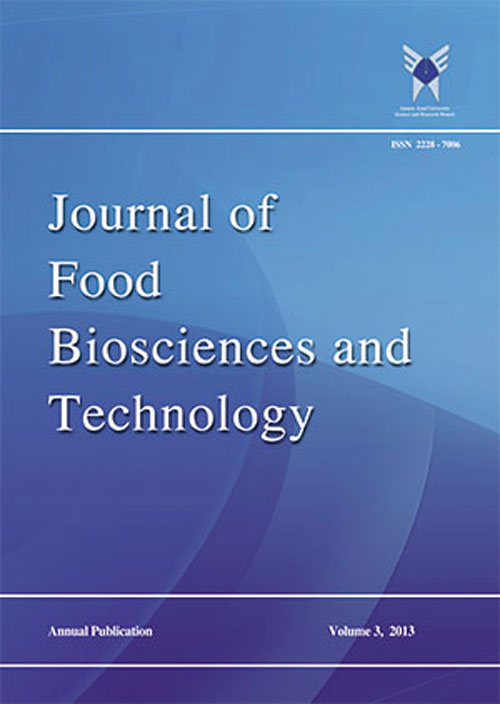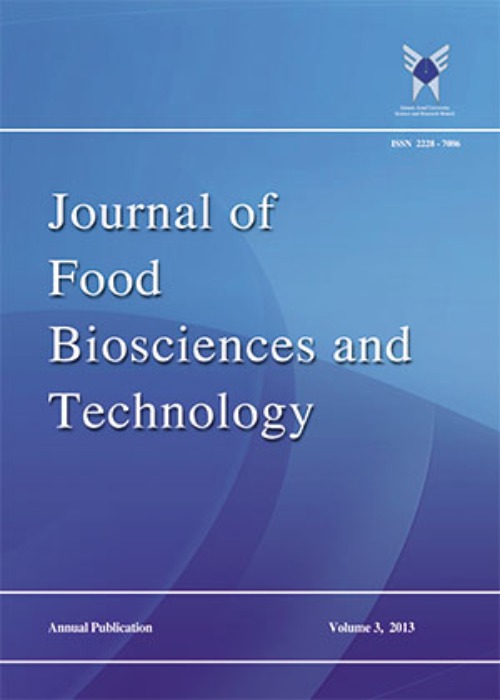فهرست مطالب

Journal of Food Biosciences and Technology
Volume:11 Issue: 1, Winter-Spring 2021
- تاریخ انتشار: 1399/10/12
- تعداد عناوین: 10
-
-
Pages 1-10
Stress relaxation has traditionally been employed as one of the principal means for measuring the viscoelastic behavior of foods. The objective of this study was to determine the texture profile analysis and stress relaxation characteristics of carrot sponge cake formulated with four different levels of guar gum (0, 0.25, 0.5 and 0.75 %). Texture profile analysis results showed a decrease in the carrot cake consistency, gumminess and chewiness with increasing the level of gum. The consistency and hardness values decreased from 4773.11 to 2260.60 g.s and 915.45 to 458.54 g with increasing guar gum levels from 0 to 0.75 %, respectively. The results showed that mechanical stress relaxation data of carrot sponge cakes were fitted well by both the Peleg-Normand and four-element Maxwell models. The F0 (initial force) and %SR (percentage stress relaxation) parameter of carrot sponge cakes decreased with increasing gum concentration (P<0.05). Although all decay forces (F1, F2 , F3 and F4) of the carrot sponge cakes obviously decreased with increasing guar gum concentration. The elasticity of the carrot sponge cakes was the highest at 0.75% guar gum concentration.
Keywords: Guar Gum, Maxwell Model, Peleg-Normand Model, Sponge cake, Stress Relaxation -
Pages 11-20
The aim of present study was to produce functional ice-cream using chicory, clove and pomegranate peel extracts and investigate the antioxidant activity, physicochemical and sensory properties of the extract.The alcoholic extracts of chicory, clove and pomegranate peel (0.5, 1 and 1.5 percent) were used in ice-cream formulation. The samples were stored for three months. The characteristics of the samples were studied on the first, 30th, 60th and 90th days.The results showed that by increasing the concentration of the extracts in the samples, viscosity significantly decreased and melting resistance and acidity increased (p <0.05). Moreover, by increasing the concentration of the extracts in the samples, their antioxidant activities increased. The highest antioxidant activity was related to the sample containing 1.5% clove extract and this sample had the most content of phenolic compounds. During storage, melting resistance and viscosity significantly decreased and acidity increased (p <0.05). The highest score of overall acceptance was related to the sample containing 0.5% chicory extract. Moreover, this sample had desirable viscosity. Considering the above mentioned points, the sample containing 0.5% chicory extract was selected as the best sample. It can be concluded that it is possible to produce the functional ice-cream with desirable physicochemical and sensory properties using 0.5% chicory extract.
Keywords: Antioxidant Activity, Chicory Extract, Clove Extract, Functional Ice-Cream, Pomegranate Peel Extract -
Pages 21-34
Malt and jujube are products with high nutritional value and wonderful medicinal properties. In order to benefit from the unique properties of both materials and to resolve problems related to malt soft drinks the production of a new beverage made of malt and jujube extracts was studied. In order to determine the optimal formulation, the central composite design (CCD) of response surface methodology (RSM) was applied. Malt extract, jujube extract and sugar were the independent variables of the design that 20 formulations were determined based on their limits. Optimization was conducted to achieve maximum phenolic content and general acceptance and the optimal formulation was determined as 2.97 ml of malt extract, 5.50 ml of jujube extract and 5.05 g of sugar per hundred ml of beverage. In order to improve optimal formulation of the drink, jujube essence was extracted and added to the drink. The physicochemical, microbial and sensory properties of the final carbonated drink of malt and jujube extracts were evaluated at production time and after three months of refrigeration. During this period, pH, acidity and Brix of the drinks did not change significantly, but the total phenol increase was significant. No microorganisms resistant to acids, yeast and mold was found in the beverage and the number of aerobic mesophilic bacteria was very low and within the standard range. Although the rate of sensory properties had decreased significantly at the end of the maintenance period, the scores were still high and within the acceptable range of judges.
Keywords: Drink, Jujube Extract, Malt Extract, Response Surface Methodology -
Pages 35-42
Sugarcane being a rich source of nutrients containing, phytocompounds, unique taste and aroma, where unrefined sugars (e.g. Panela) is produced from it. Panela is non-centrifugal cane sugar (NCS), a high carbohydrate-content food obtained by evaporation of water in sugarcane juice and is known by different name such as jaggery (South Asia), kokuto (Japan), Hakura (Srilanka), rapadura (Brazil), Gur/Desi (Pakistan) and Shekar sorkh/ Tabarzard (north of Iran). Despite the fact that panela has great properties and components, Panela is a relatively unknown product in Iran. According to the following literature review work and analysis provide and gain more information concerned with this product and its functional properties.
Keywords: Food Composition, Health Benefit, Jaggary, Non-Centrifugal Sugarcane, Panela, review -
Pages 43-54
Ultrasound-osmotic dehydration as a pretreatment prior to drying can reduce the cost and processing time while increasing drying efficiency. This study evaluated the effectiveness of bath and probe ultrasound-assisted osmotic dehydration, as a pretreatment of the drying process in an oven, on the qualitative characteristics of peach slices. Different conditions of pretreatment such as type of ultrasound (bath, probe), ultrasound temperature (25, 45 °C), ultrasound time (15, 30 minutes) and probe ultrasound intensity (75, 100 %) were investigated on the efficiency of osmotic dehydration, water activity, shrinkage, texture, rehydration, color, and vitamin C. The highest efficiency of osmotic dehydration was for the pretreated sample by probe ultrasound (45 °C-15'-100%). Osmotic-ultrasound pretreatment caused tissue stiffness, reducing in shrinkage and rehydration in the sample due to absorption of solids. Probe ultrasound, especially at high temperatures, compared with the bath ultrasound increased the total color difference and decreased the amount of vitamin C in the samples. Finally, in terms of overall acceptance, the samples under the bath ultrasound (25 °C-30 ') and under the probe ultrasound (25 °C-15'-100%) had the highest score.
Keywords: Drying, Invert Syrup, Osmotic Dehydration, Peach, Ultrasound -
Pages 55-58
The vast numbers of studies and research works have been carried out concerned with various methods to identify and detect the origin of vegetable oils. Although all have been approved and applied but due to time and economical constraints a quick and fast procedure is required. In this preliminary study tocopherols identification by High Pressure Liquid Chromatography might be considered as a method to be adopted. Commercial vegetable oils (sesame, olive, maize, canola, sunflower, soyabean) were sourced from the local industries and tocopherols contents were determined by the application of HPLC. The results indicated that the method might be considered as a reliable fast method however other methods namely determination of fatty acids and triglyceride profiles and sterol composition might be required for firm identification of oils that might have very similar tocopherol specifications and composition.
Keywords: Nonsaponifiable Matters, Tocopherols, Tocols, Vegetable Oils -
Pages 59-68
In order to evaluate the efficacy of high-resolution melting (HRM) analysis in the detection and discrimination of S. typhimurium and S. enteritidis, this study was conducted on 30 samples of raw eggs, where 14 treatments were employed: 4 groups of samples contaminated with Salmonella typhimurium, 4 with S. enteritidis, 4 with a mixture of both, as well as 2 control groups. DNA was extracted from the contaminated samples and used for preparation of a target DNA sequence using an invA gene-specific primer pair. RT-PCR identified and detected Salmonella in the contaminated egg samples within less than 24 hours, and HRM analysis proved that this method is suitable for the discrimination of the S. enteritidis and S. typhimurium species. The sensitivity of this method was equal to 200 Salmonella cells per microliter, and HRM analysis could distinguish S. enteritidis and S. typhimurium and their combination with high consistency (R2 > 0.993).
Keywords: HRM, Melting Curve, Real Time-PCR, Salmonella enteritidis, Salmonella typhimurium -
Pages 69-80
The thin-layer drying behavior of Grapefruit slices is experimentally investigated in a convective dryer and the mathematical modeling by using thin-layer drying models is performed. In the present study, tests were conducted using three air temperatures (45, 55, 65 °C), two hot air velocities (1 and 2 ms-1), two-bed depth (1 and 2 cm) and three replications for each treatment. Based on the results, the best drying time was measured at 65 °C, hot air velocity of 2 ms-1 and bed depth of 1cm for 73 min. The calculated maximum value of effective moisture diffusivity coefficient was 7.44 × 10-8 m2s-1, and the minimum activation energy was 16.09 kJ.mol-1, at 65 °C, hot air velocity of 2 ms-1 and bed depth of 1cm. In the same vein, the maximum value of vitamin C (32.03 mg. (100 g)-1) was obtained at 55 °C, hot air velocity of 2 ms-1 and bed depth of 1cm. In addition, the page equation was found to give better predictions than the others. It is worth to note that the minimum value of change color (23.76) was measured at 45 °C, hot air velocity of 2 ms-1 and bed depth of 1cm.
Keywords: Activation energy, Diffusivity, Grapefruit, Hot Air Drying, Mathematical Modeling -
Pages 81-92
The present study was performed to evaluate the influence of solvent polarity on antioxidant and radical scavenging activity of the extracts of red onion skin. Extracts were obtained using sequential extraction method with various solvents namely ethyl acetate, n-butanol, methanol and water. Ethyl acetate and n-butanol extracts demonstrated the highest total phenolic (577.310±9.2 and 441.379±7.3 mg GAE/g extract, respectively) and flavonoids contents (36.188±5.1 and 33.844±4.6 mg QE/g extract, respectively), as well asthe highest antioxidant capacity compared to methanolic and waterextracts through all antioxidant assays.The results showed that all extracts exhibited antioxidant activity in a concentration-dependent manner. Significant correlation was obtained between antioxidant activities and total flavonoids.The highest DPPH and nitric oxide radical scavenging were acquired for n-butanol extract.Furthermore, ethyl acetate extract displayed the most reducing power.The results indicated that the components with antioxidant properties in onion skin were extracted in non-polar solvents more than polar solvents.
Keywords: Antioxidant Activity, Red Onion Skin, sequential extraction, solvent polarity -
Pages 93-103
Mayonnaise is a semisolid emulsion that is made by mixing oil with mustard, egg yolk, vinegar and is sensitive to spoilage due to its high polyunsaturated fatty acids content. The amount of oil and egg yolk added, viscosity, water quality, the volume of oil and aqueous phase, method of mixing and temperature affect the stability of mayonnaise. Phase inversion occurs when the emulsion changes from the oil-in-water (O/W) emulsion to the water-in-oil (W/O) emulsion. Egg yolk as an emulsifier has surface-active fractions such as livetin, lipovitellin, lipovitellenin that prevent coalescing and improve the texture. Phospholipid lecithin, proteins, and lipoproteins are known to be the most important to the emulsion forming properties of egg yolk. Other emulsifying agents include animal proteins, vegetables protein isolates, modified starches and gums which can be effectively used as food emulsion stabilizers because of their capacity to reduce the interfacial tension between hydrophobic and hydrophilic components. Temperature, pH and NaCl are effective on viscoelasticity of mayonnaise emulsion. Emulsifiers increase the prevalence of metabolic diseases, specially type 1 and 2 diabetes, obesity and irritable bowel disease. Currently the tendency of the consumers to purchase the food products with low fat and low energy is led to reformulation that often requires moving from one sort of emulsifier to another. In this study, different emulsifiers and their effects on the characteristics of mayonnaise were reviewed.
Keywords: Mayonnaise, Emulsion, Emulsifiers, Egg Yolk, Stability


